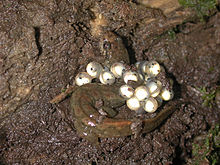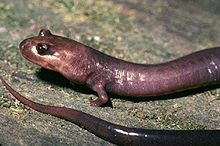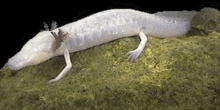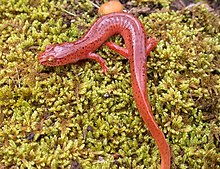Lungless salamanders
| Lungless salamanders | ||||||||||||
|---|---|---|---|---|---|---|---|---|---|---|---|---|

Brown brook salamander ( Desmognathus fuscus ) |
||||||||||||
| Systematics | ||||||||||||
|
||||||||||||
| Scientific name | ||||||||||||
| Plethodontidae | ||||||||||||
| JE Gray , 1850 |
The lungless salamanders (Plethodontidae) form by far the most species-rich family of the caudate amphibians (caudata or urodela). They make up two thirds of all species of this order. The scientific name is derived from the Greek words "pletho" (= amount) and "odontes" (= teeth), which could indicate the enlarged teeth in the upper jaw of some species.
features



The representatives of this highly variable family usually have no or (more "primitive" at the stream salamanders) rudimentary existing lung . The oxygen uptake occurs instead through perspiration (including their special form of mouth breathing ). The total length of the adult animals varies, depending on the species, between little more than three and 22 centimeters. Several representatives of the Thorius genus, which is restricted to Mexico, have head-to-trunk lengths of less than two centimeters (plus tail length). As a rule, the animals each have four fingers and five toes; However, miniaturized species sometimes have hind feet reduced to four toes. Lungless salamanders often have a slender, elongated body (with up to 60 vertebrae), a long tail and move very agile by swimming, climbing or even jumping. With a shallow nasal-lip groove that runs from the nostril to the upper lip and is lined with partially swollen glands , smells are perceived or passed on to olfactory cells in the nose. The olfactory orientation plays an important role, for example in the sometimes complex courtship and territorial behavior. Many species also have large eyes and can prey on nimble insects with a flicking tongue.
Occurrence
The focus of the distribution is in North, Central and South America between southern Alaska and southern Canada on the one hand and northwestern Brazil and central Bolivia on the other. Most of the species live in the USA, and especially in the Appalachians . The Lungless Salamanders are the only salamanders that penetrate the tropical area and just barely cross the equator in northern South America .
Outside America, only the genus European cave salamanders ( Speleomantes ) with currently eight species is found in Europe - more precisely in Sardinia as well as in southern France and Italy. (In some systematics these are listed together with three American species under the genus Hydromantes and Speleomantes is understood as "clade". In addition, a separate genus Atylodes has recently been postulated for the Genés cave salamander .) In 2005, a new species was also introduced in Korea discovered, which is placed in its own genus Karsenia .
Way of life
In addition to some representatives of the species of the brook salamander ( Desmognathus ) living near water, there are also underground salamanders such as the blind salamander ( Haideotriton wallacei ). Most species, however, live above ground on land all year round. In these cases, the embryonic and larval development takes place exclusively terrestrially within larger egg shells , so that - unlike most amphibians - no body of water is required for the life cycle (example: genus forest salamander , plethodon ). Some even live in tall trees at times (genus tree salamander , Aneides ). Only a few taxa still have a (partial) larval phase in the water, such as the black-bellied brook salamander ( Desmognathus marmoratus ) or the brown brook salamander ( Desmognathus fuscus ). A striking feature of the reproductive behavior of the Plethodontidae are the so-called mating marches, in which the partners clasp each other temporarily and move forward until the spermatophores are passed indirectly .
Lungless salamanders generally prefer moist hiding spots that they only leave in rainy weather and at night. They have a low metabolic rate and survive longer periods of dry or cold periods when they are resting because they store part of their food as fat reserves. Their main phases of activity are spring and autumn. To ward off predators, some species produce a poisonous and very sticky skin mucus that a smaller snake can choke on. Other species can shed their tail like a lizard .
evolution
The Plethodontidae were originally probably inhabitants of cool mountain streams in eastern North America - just like some brook salamanders today. Under the living conditions of rapidly flowing water, the lungs gradually regressed because they were disadvantageous due to their buoyancy . The further development of the phylogenetic history led to an ever greater independence from waters and also to the expansion to the west, until the tropics were finally settled via the Central American land bridge. The completely terrestrial living representatives from the genus forest salamander ( Plethodon ) can thus be regarded as the most highly developed forms.
The European deposits - as well as the new Korean find - are to be understood in this context as relics from the Paleogene (formerly known as the Tertiary ), i.e. as remnants of the epoch after the disintegration of Pangea , when the North American subcontinent and Eurasia were still called a common large land mass Laurasia formed.
Taxonomy
Older systematics of the lungless salamanders consisted of the subfamilies Desmognathinae and Plethodontinae, such as that of David B. Wake from 1966. It was based on morphological and anatomical findings, mainly considering the bone structure, and remained valid for many years. Only the introduction of molecular genetic methods in 2004 brought about a change by Chippindale et al. The three tribes of the Plethodontinae became the subfamilies Bolitoglossinae, Hemidactyliinae and Plethodontinae. The Desmognathinae were assigned to the new extent of the Plethodontinae. The Hemidactyliinae (at that time also written Hemidactylinae) were reduced to the four-toed salamander and were thus monogeneric and monotypic . The other species that had previously been in the tribe Hemidactyliini were placed in a new subfamily, the Spelerpinae. Thus there were four subfamilies (Bolitoglossinae, Hemidactyliinae, Plethodontinae and Spelerpinae) within the lungless salamanders. But it soon turned out that the lungless salamanders can be divided into two major lineages: The Hemidactyliinae with the groups Bolitoglossini , Hemidactyliini (only the four- toed salamander) and Spelerpini as well as the Plethodontinae. The composition of the genres within the individual groups remained largely the same, but they were assigned to different ranks. Taking into account further phylogenetic studies, Wake summarized the systematic classification of the 431 species described at that time in 2012.
Systematics
Subfamilies, tribe, genera, subgenera and selected species according to Amphibian Species of the World:
Subfamily Hemidactyliinae Hallowell , 1856
- Tribus Batrachosepini
- Genus Batrachoseps Bonaparte , 1839 - worm salamander (22 species)
- Subgenus Batrachoseps Bonaparte , 1839
- Subgenus Plethopsis Bishop , 1937
- Genus Batrachoseps Bonaparte , 1839 - worm salamander (22 species)
- Tribus Bolitoglossini Hallowell , 1856
- Genus Bolitoglossa Duméril , Bibron & Duméril , 1854 - Mushroom-Tongue Salamander (121 species)
- Subgenus Bolitoglossa Duméril , Bibron & Duméril , 1854
- Subgenus Eladinea Miranda-Ribeiro , 1937
- Magnadigita Taylor subgenus , 1944
- Subgenus Mayamandra Parra-Olea , García-París & Wake , 2004
- Subgenus Nanotriton Parra-Olea , García-París & Wake , 2004
- Subgenus Oaxakia Parra-Olea , García-París & Wake , 2004
- Subgenus Pachymandra Parra-Olea , García-París & Wake , 2004
- Art Bolitoglossa dofleini Werner , 1903 - Large palm salamander
- Genus Bradytriton Wake & Elias , 1983 (1 species)
- Art Bradytriton silus Wake & Elias , 1983
- Genus Chiropterotriton Taylor , 1944 - Callus salamander (12 species)
- Species Chiropterotriton mosaueri Woodall , 1941
- Genus Cryptotriton García-París & Wake , 2000 (7 species)
- Genus Dendrotriton Wake & Elias , 1983 (8 species)
- Genus Ixalotriton Wake & Johnson , 1989 (2 species) (in some reviews only a synonym for Pseudoeurycea )
- Genus Nototriton Wake & Elias , 1983 (16 species)
- Genus Nyctanolis Elias & Wake , 1983 (1 species)
- Species Nyctanolis pernix Elias & Wake , 1983
- Genus Oedipina Keferstein , 1868 - Tropical salamander (36 species)
- Subgenus Oedipina Keferstein , 1868
- Species Oedipina paucidentata Brame , 1968
- Art Oedipina poelzi Brame , 1963
- Subgenus Oeditriton McCranie , Vieites & Wake , 2008
- Subgenus Oedipinola Hilton , 1946
- Subgenus Oedipina Keferstein , 1868
- Genus Parvimenue Taylor , 1944 (1 species)
- Art Parvimenue townsendi ( Dunn , 1922) (in some reviews only a synonym for Pseudoeurycea )
- Genus Pseudoeurycea Taylor , 1944 - Mexico salamander (49 species)
- Species Pseudoeurycea leprosa Cope , 1869
- Species Pseudoeurycea naucampatepetl Parra-Olea , Papenfuss & Wake , 2001
- Species Pseudoeurycea saltator Lynch & Wake , 1989
- Genus Thorius Cope , 1869 (23 species)
- Genus Bolitoglossa Duméril , Bibron & Duméril , 1854 - Mushroom-Tongue Salamander (121 species)
- Tribus Hemidactyliini Hallowell , 1856
- Genus Hemidactylium Tschudi , 1838 (1 species)
- Species Hemidactylium scutatum ( Temminck & Schlegel , 1838) - four-toed salamander
- Genus Hemidactylium Tschudi , 1838 (1 species)
- Tribus Spelerpini Cope , 1859
- Genus Eurycea Rafinesque , 1822 - Yellow salamander (26 species)
- Art Eurycea rathbuni ( Stejneger , 1896) - Texan fountain newt
- Genus Gyrinophilus Cope , 1869 - source Salamander (4 kinds)
- Genus Haideotriton Carr , 1939 - Blindsalamander (1 species) (in some overviews only a synonym of Eurycea )
- Genus Pseudotriton Tschudi , 1838 - Mud salamander (2 species)
- Art Pseudotriton ruber ( Sonnini de Manoncourt & Latreille , 1801) - Red salamander
- Genus Stereochilus Cope , 1869 - Striped salamander (1 species)
- Species Stereochilus marginatus ( Hallowell , 1856)
- Genus Urspelerpes Camp , Peterman , Milanovich , Lamb , Maerz & Wake , 2009 (1 species)
- Art Urspelerpes brucei Camp , Peterman , Milanovich , Lamb , Maerz & Wake , 2009
- Genus Eurycea Rafinesque , 1822 - Yellow salamander (26 species)
Subfamily Plethodontinae Gray , 1850
- Tribus Aneidini Wake , 2012
- Genus Aneides Baird , 1851 - Tree salamander (6 species)
- Species Aneides lugubris ( Hallowell , 1849) - Alligator salamander
- Genus Aneides Baird , 1851 - Tree salamander (6 species)
- Tribus Desmognathini Baird , 1850
- Genus Desmognathus Baird , 1850 - Brook salamander (21 species)
- Genus Phaeognathus Highton , 1961 - Creeping salamander (1 species)
- Species Phaeognathus hubrichti Highton , 1961
- Tribe Ensatinini Gray , 1850
- Genus Ensatina Gray , 1850 (1 species)
- Art Ensatina eschholtzi Gray , 1850 - Eschscholtz-Salamander
- Genus Hydromantes Gistel , 1848 (13 species)
- Subgenus Atylodes Gistel , 1868
- Art Hydromantes ( Atyloides ) genei ( Temminck & Schlegel , 1838) - Genés Höhlensalamander (in some overviews under Hydromantes (Speleomantes) genei )
- Subgenus Hydromantes Gistel , 1843
- Art Hydromantes brunus Gorman , 1954
- Art Hydromantes platycephalus Camp , 1916
- Art Hydromantes samweli Bingham , Papenfuss , Lindstrand & Wake , 2018
- Art Hydromantes shastae Gorman & Camp , 1953
- Art Hydromantes wintu Bingham , Papenfuss , Lindstrand & Wake , 2018
- Subgenus Speleomantes Dubois , 1984
- Art Hydromantes ( Speleomantes ) ambrosii Lanza , 1954 - Ambrosis Höhlensalamander
- Species Hydromantes ( Speleomantes ) flavus Stefani , 1969 - Monte Albo cave salamander
- Art Hydromantes ( Speleomantes ) imperialis Stefani , 1969 - Fragrant cave salamander
- Art Hydromantes ( Speleomantes ) italicus Dunn , 1923 - Italian cave salamander
- Art Hydromantes ( Speleomantes ) sarrabusensis ( Lanza , Leo , Forti , Cimmaruta , Caputo & Nascetti , 2001) - Sàrrabus cave salamander
- Art Hydromantes ( Speleomantes ) strinatii Aellen , 1958 - Ligurian Cave Salamander
- Art Hydromantes ( Speleomantes ) supramontis Lanza , Nascetti & Bullini , 1986 - Sopramonte cave salamander
- Subgenus Atylodes Gistel , 1868
- Genus Karsenia Min , Yang , Bonett , Vieites , Brandon & Wake , 2005 (1 species)
- Art Karsenia koreana Min , Yang , Bonett , Vieites , Brandon & Wake , 2005
- Genus Ensatina Gray , 1850 (1 species)
- Tribus Plethodontini Tschudi , 1838
- Genus Plethodon Tschudi , 1838 - Forest salamander (55 species)
- Subgenus Hightonia Vieites , Nieto-Román , Wake & Wake , 2011
- Subgenus Plethodon Tschudi , 1838
- Species Plethodon glutinosus ( Green , 1818) - silver salamander
- Art Plethodon jordani Blatchley , 1901 - Red-cheeked wood salamander
- Genus Plethodon Tschudi , 1838 - Forest salamander (55 species)
Individual evidence
- ↑ David B. Wake : Comparative osteology and evolution of the lungless salamanders, family Plethodontidae. Memoirs of the Southern California Academy of Science, 4, pp. 1-111, 1966
- ↑ PT Chippindale, RM Bonett, AS Baldwin, JJ Wiens: Phylogenetic evidence for a major reversal of life-history evolution in plethodontid salamanders. Evolution, 58, pp. 2809-2822, 2004
- ^ A. Dubois: Amphibia Mundi 1.1. An ergotaxonomy of recent amphibians. Alytes, 23, pp. 1-24, 2005
- ↑ David Burton Wake: Taxonomy of Salamanders of the Family Plethodontidae (Amphibia: Caudata) . Zootaxa, 3484, pp. 75-82, 2012
- ↑ Darrel Frost and The American Museum of Natural History: Plethodontidae Amphibian Species of the World, 1998-2013
literature
- Kurt Rimpp: Salamanders and Newts . Ulmer, Stuttgart 1978, ISBN 3-8001-7045-0 .







